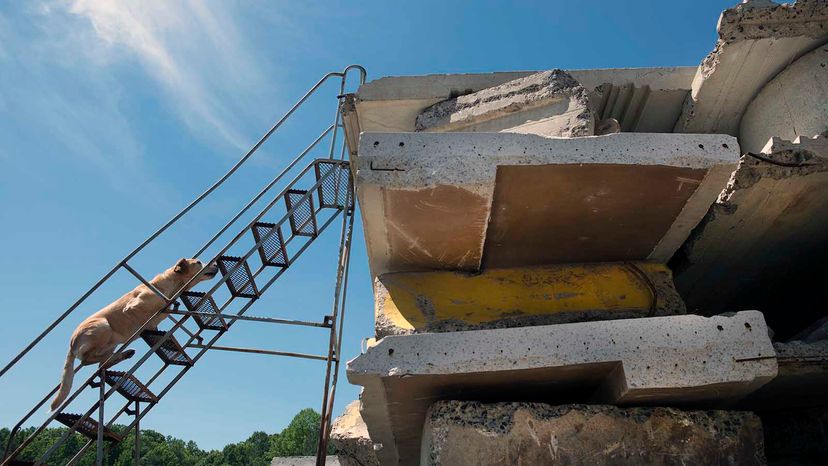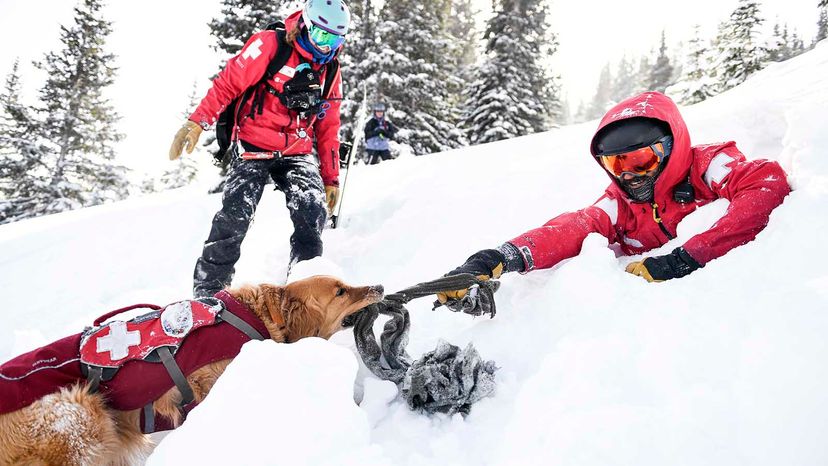SAR Dog Training

It may seem like a dog obsessively focused on play would make a poor working dog, but for search-and-rescue work, this is actually an ideal trait. A dog that will chase a tennis ball for hours would probably walk through feet of snow, over a mountain and down a rocky embankment until his paws bleed to find it — and get someone to throw it for him again. For this SAR dog, locating the origin of a human scent would mean a game of "find the ball." This is the basis of SAR training: associating human scent with something the dog wants very badly.
The central jobs of a SAR dog are to find a human scent ("find it") and effectively alert his handler to its location. SAR training assures that a dog can complete these tasks in all conditions, regardless of weather or distractions. Depending on the dog's specialty area, his core training may also include the recall-find ("show me"), in which he finds a person, returns to his handler and then leads the handler back to the person, or victim loyalty, in which the dog stays with the person and alerts his handler by barking.
Advertisement
Most SAR dogs live and train with their handler, and it takes about 600 hours of training for a dog to be field ready. Sometimes, SAR associations adopt dogs from shelters for the specific purpose of training them for search and rescue, and they'll train at a special facility and then be paired with a handler. Potential SAR dogs should also be obedient and attentive, have a friendly temperament (they're going to be working closely with strangers and other dogs in a search situation) and possess a strong desire to please.
Obedience and focus are crucial. A handler must be able to control their dog at all times and in all situations. But a SAR dog who can't think for itself is useless; air-scent dogs work off-leash, so the handler won't always be nearby to give commands. The ideal search dog can solve problems on his own but also always be aware of his handler.
The general approach to training a dog for search and rescue is no different from training a dog to complete any other task. The first step is to figure out which reward the dog will work for, and always immediately reward the dog when he does the right thing. In the course of training, handlers associate that reward with each thing they want the dog to do. The case of SAR dogs, it's locate human scent and alert the handler as fast as possible. The training starts out with very simple tasks and gets progressively more complex as the dog completes each level.

Example: Avalanche Training
Training a dog to "find it" is more about directing a dog than teaching her. Dogs have a natural inclination to locate scents — SAR training involves letting a dog know which scent the handlers wants her to locate and where the scent might be. Each time the dog completes a task, she gets her reward. Let's say this particular dog works for games of tug-of-war with a stinky sock.
For avalanche training, the first step is simply to get the dog to search under the snow. The handler digs a hole in the snow, and a second person holds the dog while the handler makes a big show of running away and jumping into the hole while the dog watches. When the assistant releases the dog, she runs to find the handler. When she finds the handler, they play tug-of-war. This gets the dog interested in finding people.
The next step is to increase the amount of time the assistant holds the dog. This increases the level of memory and attention span required to find the handler. First, the assistant holds back the dog for, say, five seconds. The dog finds the handler and gets to play tug-of-war. Then the assistant holds the dog for 10 seconds, then one minute, then five minutes and so on. Each time the dog finds the handler, she is rewarded with her game of tug-of-war.
Now the handler adds another complication: An assistant covers the handler with a few inches of snow. This time, when dog runs to find the handler, she can't see him, but she can smell him. So she starts digging. When she finds him, she gets her stinky sock. Now the dog discovers that people can be beneath the snow and that human scent emanating from snow means that digging in that spot will reveal a person who might play with her. Then, the handler and assistant change places, and the handler manages the dog while the assistant hides. By this stage, the game is well established, and the dog knows what she needs to do to get her reward.
Finally, distractions are added. The dog begins playing the "find it" game with people and dogs milling about the area and avalanche-search equipment, like poles and shovels, lying around. In a real avalanche search, distractions are everywhere, and the dog must be able to focus on the search despite the chaos.
Once a dog really gets the game of "find it," training her to alert to the find should be easy. In the case of avalanche searches, dogs usually dig at the area where they detect human scent. If a reward immediately follows a correct alert (meaning the dog is digging in the right place), the dog will continue to alert in that manner.
A field-ready SAR dog can focus on the task at hand — whatever his handler is commanding him to do — no matter what. The dog maintains vigilance and dedication to the search through all types of weather conditions and navigates treacherous terrain without losing confidence.